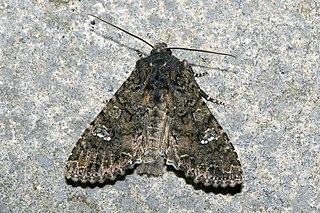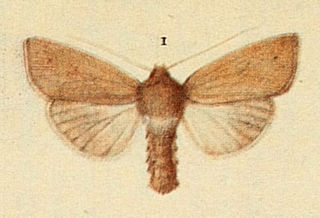
The cabbage moth is primarily known as a pest that is responsible for severe crop damage of a wide variety of plant species. The common name, cabbage moth, is a misnomer as the species feeds on many fruits, vegetables, and crops in the genus Brassica. Other notable host plants include tobacco, sunflower, and tomato, making this pest species particularly economically damaging.

Mythimna impura, the smoky wainscot, is a moth of the family Noctuidae. The species was first described by Jacob Hübner in 1808. It is distributed throughout most of the Palearctic realm from Ireland in the west of Europe east to the Caucasus, Turkey, Syria, Kazakhstan, Russia, Siberia, Mongolia, then Japan. In Europe it is found from the Arctic Circle to Spain and Italy in the south, as well as in the northern regions of Greece.

The poplar grey is a moth of the family Noctuidae. It is found throughout Europe.

Apamea remissa, the dusky brocade, is a species of moth of the family Noctuidae. It is distributed throughout Europe and Turkey, ranging across the Palearctic realm to Siberia, Manchuria and Japan. It has also been reported from Alaska.

Plusiinae is a smallish subfamily of the moth family Noctuidae. As the Noctuidae appear to be a paraphyletic assemblage, the Plusiinae may eventually be raised to family status.

Heliothis peltigera, also known as the bordered straw, is a species of moth of the family Noctuidae.

Mythimna favicolor, or Mathew's wainscot, is a moth of the family Noctuidae. The species was first described by Charles Golding Barrett in 1896. It is found in Europe. The species is sometimes treated as a subspecies of Mythimna pallens, the common wainscot.

Euchalcia is a genus of moths of the family Noctuidae.

Euchalcia variabilis, the purple-shaded gem, is a moth of the family Noctuidae.

Euchalcia consona is a moth of the family Noctuidae. It is found in Europe from Austria, through Hungary and Siberia up to the Ural mountains.

Euchalcia modestoides is a moth of the family Noctuidae. It is found from the temperate areas of central Europe, east to Japan.

Coenophila subrosea, the rosy marsh moth, is a moth of the family Noctuidae. The species was first described by James Francis Stephens in 1829. It is found from southern Great Britain, Italy and France, through central Europe north to Scandinavia, east to Russia, from Siberia to the Amur region, Ussuri and Sakhalin, south to northern China, east to Korea and northern Japan.
Pyrocleptria cora is a species of moth of the family Noctuidae. It has a very scattered distribution in Europe. It is known from a few localities in Romania and Russia as well as two locations in the Hautes-Alpes in France.

Lithophane socia, the pale pinion, is a moth of the family Noctuidae. The species was first described by Johann Siegfried Hufnagel in 1766. It is found throughout western Europe from Spain to central Scandinavia then east across the Palearctic to Siberia, the Russian Far East and Japan.

Denticucullus pygmina, the small wainscot, is a moth of the family Noctuidae. It is found in most of Europe, ranging from northern Spain, through Portugal as far north as Finland. In the east it is found across the Palearctic to the Russian Far East and western Siberia. It is also found in North Africa, Turkey, the Caucasus region and northern Iran.

The double-spot brocade is a species of moth of the family Noctuidae. It is found in most of Europe, in Turkey and the west of Iran. In Anatolia it is represented by the subspecies Meganephria bimaculosa pontica.

Griposia aprilina, also known as the merveille du jour, is a moth of the family Noctuidae, found in Asia and Europe. The species was first described by the Swedish taxonomist, Carl Linnaeus in his 1758, 10th edition of Systema Naturae.

Callopistria latreillei, Latreille's Latin, is a moth of the family Noctuidae. The species can be found in the Palearctic realm, most parts of Europe, Asia, and in Africa from Egypt to South Africa. The habitat consists of rocky limestone slopes with deciduous woodland.

Athetis hospes, or Porter's rustic, is a moth of the family Noctuidae which was described by Christian Friedrich Freyer in 1835. It is found in Spain, southern France, Italy, on the Balkan Peninsula, Crete, Turkey and northern Iran. The species seems to be expanding its range in north-western Europe with records from Great Britain and the Netherlands.

Eucarta amethystina is a moth in the family Noctuidae first described by Jacob Hübner in 1803. It is found in central Europe, east to Belarus, through the Ural to the Pacific Ocean.

















